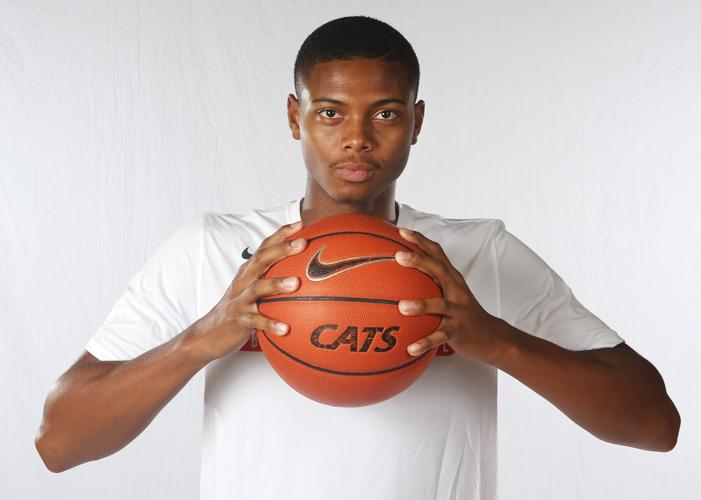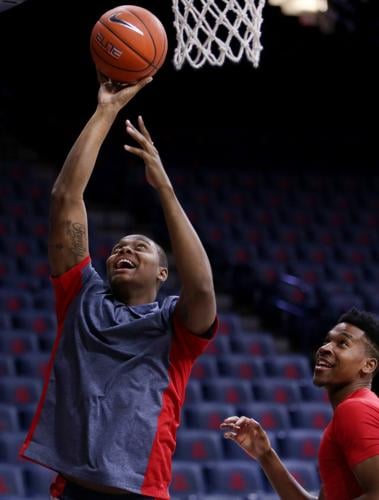LAS VEGAS — “I can’t believe it’s been five years. Five years just seems like it went too fast.”
Ray Smith remembers the moment his basketball-playing career came to a screeching halt like it was yesterday.
In the Arizona Wildcats’ 86-35 exhibition win over College of Idaho to begin the 2016-17 season, Smith — a Las Vegas native and former five-star recruit — went up for a lay-up. When he landed, he tore his ACL for the third time in as many years.
“I remember going up for a rebound and then my leg buckled a little and they took me out of the game. They asked me, ‘Do you still want to go?’ They thought I should’ve sat down and not played. I was so eager, because it had been three years,” Smith said. “I was so eager, so I was like, ‘No, this is going to work now.’ And I felt good. I had my first rebound, got some free throws in, I was excited and then Kobi Simmons gave up the ball to me on a fast break.
“Looking back, I probably should’ve thrown Kobi the lob, but I was eager and excited and wanted to show my talents. I went up for a lay-up on the left side with the right hand, I came down on the right leg and felt that excruciating pain, that intense pop you could hear even with 15,000 people there. I just kind of knew. I went to the bench and was like, ‘Yeah, this is over.’”
Smith knew better than most what a torn ACL looked and felt like. He missed his entire senior season at Las Vegas High School after the first ACL injury, with the second time happening in his freshman season at the UA. He knew a third tear was likely career-ending.
“To be honest, I was fed up with being hurt,” he said. “I love the game, but I knew it was time for me to mature and grow and find another avenue. I knew it was over for me, because it was so mentally taxing.
“People always told me I should rehab and try again. Yeah, I could’ve. But for me, I knew I wasn’t going to attack the rehab like I should.”
Smith graduated from the UA in 2019 with an undergraduate degree in social, behavioral and human understanding. He returned to Las Vegas, where he is pursuing a master’s degree in clinical mental health counseling from Grand Canyon University. (Smith is taking his classes online.)
“I’ve always wanted to do some kind of counseling. I feel like being there for somebody through hard times is really a help. Sometimes, it’s as simple as being an ear for somebody,” he said. “A lot of people tend to feel on their own during hard times, so if I could help people instead of them seeking substances or anything else that may affect them physically, that’s what I’m trying to get into.”
Though he no longer plays, Smith remains involved in basketball. He’ll soon become the coach of a San Diego-based AAU team’s U16 quad. He said he’d like work in basketball operations for an NBA team.
“I’m still figuring some things out and figuring out what direction I want to go towards,” Smith said.
Smith spoke to the Star about how he overcame a career-ending injury, his next journey and gave his thoughts on the current Wildcats as they prepare for the NCAA Tournament.
Did what you went through with your ACL injury inspire you to become a mental health counselor?
A: “Oh, yeah. Going through the ACL tear was tough, man. And people don’t understand the mental battle of going through an injury like that. A lot of people tend to cater towards the physical battle, but the mental battle is just as hard — if not harder. If you’re an athlete going through an ACL tear, you know how to push your body. That’s just what it is, you’ve been pushing your bodies for years, running that extra suicide (drill) and doing that extra push-up; however, the mental battle is much more difficult because you feel good and want to play, but you can’t. You might have to be assisted taking showers for the first couple weeks. There’s a plethora of problems that you go through recovering from an ACL tear or any kind of tendon tear in your legs or shoulders. It’s just always hard.”
What was it like having to experience years of pain during the recovery process?
A: “In the beginning, it was really hard. There were a lot of bad times and a lot of good times. But the thing that brought me out and made me understand who I am was my ability to help others, affect them, speak to them and try to identify some of the things that I went through. I remember Brandon Williams was going through knee problems during his time at Arizona, and Coach (Sean) Miller had me talk to him. I just sent him a text. I don’t know how much it helped, but I just wanted to be that guide and voice. I also found a lot of things I love outside of basketball, like my love for music. I always tried to find the positives in life and that helped me get from a pretty bad decision to stability and grow and self-love.”
What was the biggest mental challenge you faced during the rehab process?
A: “Personally for me, it was thinking you’re OK and then still telling yourself that you can’t do it. Once you feel good, that’s when the battle starts, because if you love the game truly like I did, you want to get out there and shoot a jumper, talk mess, sit down in a (defensive) stance and push your body. For some of us, it’s a paradise.”
Did you ever get the urge to start playing again?
A: “I’ve gotten the urge. You just miss it. Basketball took up a lot of my time. When there was nothing for me to do, I’d go to the gym with friends. There were so many bonding times with people and basketball was like therapy for me. I had to learn how to adapt, because I went through an identity crisis without the game. I just knew that I didn’t want to go on that level.”
What inspired you to become a coach?
A: “Coach Miller wanted me to get into that. He wanted to help me pursue that dream. However … it was hard because it was hard being out there and the injury was still so fresh. It was tough for me to be at practice every day and not compete and not be able to play. I needed time away from the whole scene and it really helped. Now I’m getting back into and drawing up plays and explaining certain things. I can relate to players on how to run a play, what they should look at, going through progressions as a quarterback would say, how to look for a bucket and help-side defense, where to be, how to help, how to hedge. Those kinds of things, being a player, I have the ability to teach the game.”
How do you like coaching Dream Vision?
A: “I love it, man. I’m not really an old guy, so the kids listen and lock in and understand that everyone is trying to help. We have our first practice before the summer next week, so I’m excited and I’m already drawing up plays and I’m just ready to get this thing going.”
What’s your impression on the current Wildcats as they prepare for the NCAA Tournament?
A: “I love the atmosphere of this team. These dudes play together, the ball never sticks and that’s why they’re so offensively efficient. Kerr (Kriisa) puts guys in a great position. Everyone knows Bennedict Mathurin, man, he’s got it. He’s not going to be there next year. (Christian) Koloko shouldn’t be there next year either. It’s funny, because when Koloko first came (to Arizona), I saw a wide-eyed freshman. You can tell he’s just matured in the game and he’s made that next step.
“Somebody I really like on this team is Dalen Terry. He’s the heart and soul of that team, because he does it all. He’s that guy that makes plays in crucial moments, whether it’s taking a charge, pushing the ball up the floor, sitting down and having hands in the passing lanes. Although he might not be statistically the guy that they look to. He reminds me of Marcus Smart, someone that’s just going to sit down and do the hard work every single day. I think he’s the heart of that team. All of them are really good players, but I think he brings more of an identity to Arizona. … Tommy Lloyd has done a great job of getting these guys to love the process, understanding there will be mistakes and just pushing through. I see him talk to guys and it’s almost like he’s one of them. There’s no ego with him and it’s just a great atmosphere. I went into that locker room and the atmosphere was great. As a college kid, that’s what you want. You want a family within a team. You can say it’s the team, but I’d like to think it’s 60-70% Tommy Lloyd, especially being a new guy. He’s created an atmosphere where it’s fun to share the ball and it’s fun to benefit off team success instead of individual. I think he’s done a great job.”
How do you reflect on your time at the UA?
A: “This is something that I always tell people and I’m forever grateful about it: I’ve had the best times at that school. I was a kid that never played in an official game and I was loved like no other. Arizona has the best fans in the country. The way they travel, the way they support, the way they indulge in their players. I still live in Las Vegas and people will stop me and be like, ‘Are you Ray Smith? I graduated from the U of A in whatever year and I’m so sorry about your story’ — it still happens, even in my city in Las Vegas. That shows me the level of love and commitment the fans have. I enjoyed my time as a student, made lifelong friends. I wouldn’t trade Arizona for any other school in the country.”





